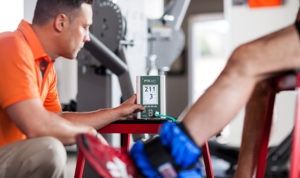Oct 6, 2022Blood Flow Restriction Training For Injured Athletes
Blood flow restriction training, also known as BFR or occlusion training, helps athletes recover from injury or surgery. It uses special equipment to safely prevent low-oxygen blood from leaving the targeted muscle. At the same time, oxygenated blood is allowed to flow to that area. This brings nutrition to the muscle and helps it grow stronger.
“Blood flow restriction helps athletes prevent muscle loss and builds strength without placing too much stress on the injured area,” explains Brian O’Reilly, PT, DPT, a physical therapist who worked with Lambert. “Essentially, you get the benefits of weight lifting without the weights.”
 BFR therapy uses specialized devices, similar to a blood pressure cuff, to create a specified amount of pressure on the affected limb. This will restrict blood flow to that area while training. The decrease in oxygen creates an anaerobic response similar to weight lifting. This helps produce more rapid muscle growth in the targeted area.
BFR therapy uses specialized devices, similar to a blood pressure cuff, to create a specified amount of pressure on the affected limb. This will restrict blood flow to that area while training. The decrease in oxygen creates an anaerobic response similar to weight lifting. This helps produce more rapid muscle growth in the targeted area.
During BFR therapy sessions, a physical therapist will carefully monitor vital signs and blood flow. Training begins by calculating your blood pressure in a position matching the exercise (lying down, standing, or sitting). The smart cuffs continuously adjust to the proper blood pressure restriction as you move. The pressure used depends on the limb location and the desired goal of training.
How does blood flow restriction help athletes recover?
During recovery from an injury or surgery, patients experience atrophy (loss of muscle tissue). This causes them to lose much of their previous strength. Unlike traditional physical therapy, BFR training uses low-intensity resistance. Because it places less stress on the injured area, athletes can start the strengthening phase of rehabilitation earlier. Earlier rehabilitation means athletes can prevent a loss in muscle mass.
Blood flow restriction therapy was used both before and after Lambert’s surgery to allow her to continue building strength in her quad and hamstring muscles. She used the training once or twice a week during the early stages of her recovery. This allowed her to keep her leg muscles strong for weight lifting later in therapy.
“For athletes like Madi, simple non-weight bearing exercises don’t challenge the muscle enough to build strength without the addition of blood flow restriction,” O’Reilly explains. “Blood flow restriction therapy helped Madi recover her strength quickly without adding additional stress or weight to her knee.”
What types of injuries are best for BFR?
Blood flow restriction training can be used to help patients with a variety of injuries, including:
- Tennis elbow
- Rotator cuff injuries
- Achilles tendonitis
- UCL injuries
- ACL injuries
- Ankle injuries
- Meniscal injuries
- Hamstring, hip, and thigh muscle injuries
This training is also be used to treat muscle strains and tendonitis, to aid recovery after surgery, and for general strengthening. “It’s important to note that blood flow restriction training is not an activity you can do at home,” says O’Reilly. “This therapy requires specialized equipment and monitoring in order to be done safely and effectively.”
» ALSO SEE: The Benefits of Battle Ropes
Patients with poor circulation, active diseases, and infections, or severe heart and lung conditions may not be good candidates for BFR training. Injuries that have little to do with weakness or muscle damage are less likely to need blood flow restriction.
But for athletes, BFR training can be a powerful tool for recovery.
*This is an excerpt from an article via Nebraska Medicine. To read the full article, click here.



